What is black and white and red all over? No, it’s not a newspaper. It’s Mute Crimson+, a hard-as-nails action platformer dripping with style. Get ready to literally paint the town red as you cut a path through aliens and demons while pushing your ninja skills to their limits.
The limited color palette serves to create a striking aesthetic while maintaining and even increasing clarity. Careful usage of grey shading and varying degrees of brightness clearly differentiate the play area from background elements and I never had trouble with determining if a platform could or could not be interacted with despite the largely greyscale color scheme. Red is a color which really stands out with an otherwise black and white environment and Mute Crimson+ is certainly not the first piece of media, nor even the first game, to make use of this effective color combo, but this game uses it better than most. Every enemy and hazard in the game contains a significant amount of red to make it immediately stand out from its surroundings and to give you a clear warning that it’s something you don’t want to touch. Our ninja protagonist is entirely black and white, but he has a thin red aura which makes his hitbox easy to discern – a trait which is essential for a game like this one where you die in a single hit and precise movement is constantly demanded of the player. This is a game which doesn’t take itself seriously in the slightest and the protagonist and enemies alike explode into red blood which covers every remotely nearby surface when they are killed. Add in a few splashes of yellow for checkpoint swords and bonus coins, an energetic chiptune soundtrack which had me humming along in nearly every stage, and increasingly ridiculous tongue in cheek cutscenes filled with deliberately excessive Engrish and it becomes hard not to fall in love with this game’s aesthetics.
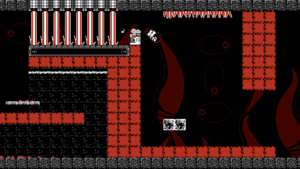
This is an action platformer with the stress strongly placed on ‘platformer’. Your character’s movement speed isn’t particularly fast, especially for a ninja, and there is no way to dash or increase momentum on your own. Outside of bosses, there are only four enemy types and, because every enemy dies in a single hit, your attack arsenal consists solely of a single slash with your sword. You do have access to a double jump, but you need to be careful with it as your midair attack animation lasts for about a second and you cannot interrupt it to jump again. This does not at all mean that Mute Crimson+ has boring level design or stiff controls. On the contrary, enemies are placed where they can most effectively combat the player and flailing around wildly is punished while precise, quick actions are rewarded.
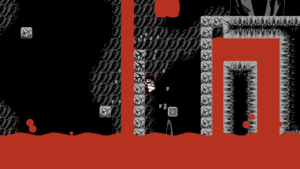
Wall climbing is a major part of Mute Crimson+. Your character will automatically cling to the side of any surface he gets near, can easily climb both upward and downward, and will remain attached to the wall even if only a small portion of his hitbox is touching it. The ninja will also only let go of the wall if you climb to the top of it, climb down and fall off of it, or jump away; there is no need to keep a button pressed and he won’t move off of the wall if you press in the opposite direction. This high amount of stickiness can take some time to get used to and it can definitely lead to some deaths; even by the end of the game there were still a few moments where I got hit by a laser or a fireball because my ninja’s foot slightly grazed the side of a platform and he ended up clinging to the side instead of standing on top. Even though it can lead to some deaths, I would say that implementing this high degree of sensitivity was absolutely the right call for this particular game. Segments where you need to climb up or down vertical shafts while avoiding hazards and jumping from one wall to the other are commonplace even early on and segments near the end get absolutely brutal with tasks such as needing to cling to the sides of single-tile laser turrets placed over pits while avoiding their timed beams and moving as quickly as possible to avoid continuously rising lava. There would almost certainly be more deaths, and ones which would be far more frustrating in nature, if the ninja didn’t latch onto walls so easily or if he constantly slid downward or let go of the wall the moment you pressed away from it or released a button like in many other games. This form of wall climbing lets Mute Crimson+ freely play with its stage design and efficiently use space by allowing for viable, precise movement in all four directions.
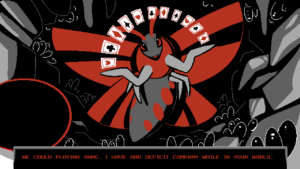
Iteration and addition are at the heart of the design philosophy here. Each stage introduces a major mechanic, such as directional wind in Stage 2 or conveyor belts in Stage 4. Every stage in turn is broken up into anywhere from five to ten smaller levels, each of which generally contains a checkpoint or two, and concepts taught in one level are carried over and expanded upon in the next. For example, Stage 3 introduces falling stalactites, crumbling platforms, and rising lava. The falling stalactites are introduces within seconds of starting the stage in a way that teaches you that they are dangerous while on the ceiling or falling (because they are red) and safe to stand on and use as platforms once they’re embedded in the ground. You are also gradually taught all the rules of crumbling blocks, such as that they still crumble even if you are climbing up their sides, that you can deliberately make gaps in vertical lines of them to switch from climbing to standing in the gap, and that enemies can also make them crumble on contact. By the end of Stage 3, you are racing rising lava while using stalactites as platforms and jumping across crumbling platforms and wall jumping between them a split second before they turn to dust.
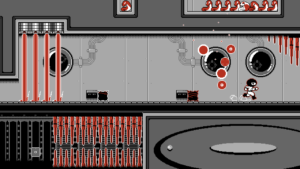
More impressively, each stage places a focus on the new mechanics and hazards it introduces while rarely abandoning old ones. The one exception to the rule is the directional wind from Stage 2, but even then an enhanced version of this mechanic permanently makes an appearance starting in Stage 5 with arrows which gently or strongly push you in a direction, including upward, until you touch a neutral marker or an arrow pointing in the opposite direction. Mute Crimson+ constantly finds new ways to use and combine every enemy, hazard, and mechanic it introduces to create new surprises all the way to the end with a level of difficulty which rises at a steady and fair pace. Even bosses follow this philosophy of iteration and gradual addition; nearly every boss fight starts with the boss using a simply attack during which it is vulnerable, then it becomes invincible while using a series of strong attacks, once again switches to using its simple attack until it is hit, then switches to a more difficult and extensive version of its strong attack, and dies after taking a third hit.
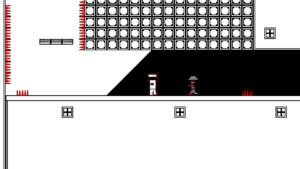
There aren’t multiple difficulty settings in Mute Crimson+, but it gives you plenty of optional content and other reasons to go back to it. Every level in the game contains a single bonus coin for a total of 49 with all sorts of goodies to unlock as you collect more of them, though you still need to make it to a checkpoint to keep the coin. The earliest and biggest unlock you get is the original XBLIG version of Mute Crimson, which has some hilariously bad artwork and the same general stage layout with both minor and significant differences in level design along the way. A boss rush and a nearly impossible ‘Arcade Mode’ where you have limited lives can also be unlocked. Several different toggles and also be unlocked and combined together however you want, such as a sprite swap or the addition of a time limit. There’s even a complete Sound Test featuring every song and sound effect, which is remarkably rare to see in a commercial game these days now that selling soundtracks has become a common practice. To top it all off, a Level Select feature also exists to make it easy to go back to any level in which you missed the coin or which you just feel like replaying.
Mute Crimson+ is an absolutely exceptional game in every way possible. With plenty of extra content, great art and music, solid gameplay, and balanced design which carefully introduces and expands upon mechanics and obstacles without ever once holding your hand, this is one of the easiest recommendations I’ve ever made.